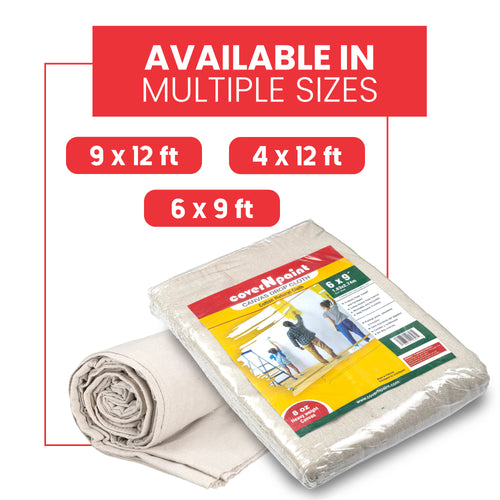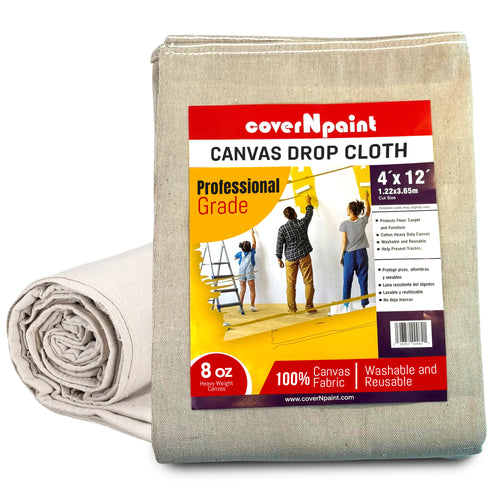Staple for DIY Enthusiasts:
Canvas drop cloths are a staple for DIY enthusiasts, professional painters, and homeowners alike. These durable, versatile cloths are perfect for protecting surfaces during painting, renovation, or other projects. However, like any tool, canvas drop cloths require proper care and maintenance to ensure they last and perform well. Whether you're using them for creative projects or home improvement, knowing how to care for your canvas drop cloths can help extend their life and keep them in top condition.
1. Pre-Washing the Canvas Drop Cloth
Before using your canvas drop cloth for the first time, consider pre-washing it. Washing helps soften the fabric, remove any chemical residues, and prevent shrinkage. Here's how you can pre-wash your drop cloth:
- Use Cold Water: Machine wash your painters drop cloth on a cold setting. Hot water can cause shrinkage, which is particularly problematic if you're using the cloth for DIY projects like curtains or table runners.
- Gentle Cycle: Run the wash on a gentle cycle to avoid too much agitation, which can wear down the fabric over time.
- Mild Detergent: Use a mild detergent to preserve the integrity of the canvas. Harsh chemicals or bleach can weaken the fibers.
- Drying: Air dry the drop cloth if possible. If you must use a dryer, set it to a low heat or no heat setting. High heat can cause shrinking and degrade the canvas quality.

2. Cleaning After Use
If you’ve used the canvas drop cloth for painting or other messy projects, proper cleaning is key to maintaining it.
- Shake Off Debris: Before washing, shake the drop cloth outside to remove any loose debris, such as dried paint chips, dust, or dirt.
- Spot Clean Stains: For stubborn stains or large paint splatters, try spot cleaning. Use a mixture of mild soap and water to gently scrub the affected area with a soft brush or sponge.
- Avoid Harsh Chemicals: If paint or other materials won’t come off, avoid using harsh chemicals like bleach or paint thinner, which can damage the fabric. Instead, allow the stain to wear off naturally over time.
3. Machine Washing Post-Use
Canvas drop cloths are usually machine washable, but it's essential to follow the right steps to prevent damage:
- Cool Water: Like pre-washing, use cold water to prevent shrinkage and maintain the fabric’s strength.
- Mild Detergent: Use a mild detergent to wash the cloth, avoiding any bleach or fabric softeners.
- Gentle Cycle: Stick to a gentle cycle to reduce wear and tear on the fabric. Even though canvas is a durable material, repeated heavy washing cycles can cause it to fray or degrade over time.
4. Drying Canvas Drop Cloths
Drying your canvas drop cloth correctly is crucial to its longevity.
- Air Dry for Best Results: The best way to dry your canvas drop cloth is to hang it up outside or in a well-ventilated area. Canvas can take longer to dry due to its thickness, so make sure it’s fully dry before folding or storing to avoid mildew.
- Tumble Dry on Low Heat: If you must use a dryer, tumble dry on the lowest heat setting possible. High heat can shrink the fabric or cause it to lose its shape.
5. Storage Tips for Canvas Drop Cloths
Storing your canvas drop cloth properly can extend its life and ensure it’s ready for use whenever you need it.
- Fold Neatly: After the cloth is completely dry, fold it neatly to avoid wrinkles. Wrinkles in canvas can lead to weak spots in the fabric over time, which might tear during use.
- Store in a Dry Place: Store your drop cloth in a dry, cool area to prevent the growth of mold or mildew. Moist environments can cause the fabric to develop musty odors and weaken the material.
- Avoid Plastic Bags: Do not store canvas drop cloths in plastic bags. This can trap moisture and lead to mold growth. Instead, opt for a breathable fabric storage bag or simply place it in a drawer or cabinet.
6. Mending and Repairing Your Canvas Drop Cloths
Even the most durable drop cloth can experience wear and tear over time. Instead of replacing it, consider repairing it with these simple tips:
- Patch Small Holes: Small holes or tears in your canvas can easily be patched with an iron-on fabric patch or sewn by hand. This will prevent the hole from getting bigger and extend the life of the cloth.
- Reinforce Weak Edges: If the edges of your drop cloth start to fray or weaken, you can reinforce them by hemming them with a sewing machine or applying fabric glue.
7. Special Care for Painted Canvas Drop Cloths
If you’ve used your canvas drop cloth as part of a DIY project like a painted table runner or curtain, you’ll want to take extra care to preserve the paint.
- Avoid Harsh Detergents: Use a mild detergent or hand-wash painted canvas drop cloths to avoid stripping the paint.
- Air Dry Only: Painted cloths should always be air-dried. Tumble drying can cause the paint to crack or fade.
- Iron with Care: If you need to remove wrinkles from a painted canvas, use a low-heat iron on the unpainted side to avoid damaging the paint.

8. Rotating Your Canvas Drop Cloths
For professional painters or DIY enthusiasts who use canvas drop cloths regularly, it’s a good idea to have more than one on hand. By rotating the cloths, you can ensure that each one has adequate time to dry and rest between uses. This can prevent excessive wear and tear on any one cloth and extend the life of all of them.
9. Consider Different Sizes for Different Projects
Canvas drop cloths come in various sizes, and having different sizes for different projects can help you maintain the cloths more easily. Smaller cloths are easier to wash and store, while larger ones are great for bigger projects like room painting. Cover N Paint offers canvas drop cloths in a range of sizes, perfect for any type of project.
10. Why Choose Canvas Drop Cloths Over Other Materials?
While there are many materials available for protecting surfaces during projects, canvas is often the best choice due to its durability and eco-friendliness. Plastic drop cloths may be cheaper, but they are less durable, less absorbent, and create more waste. Canvas drop cloths, on the other hand, are reusable, washable, and biodegradable, making them an environmentally friendly option.













